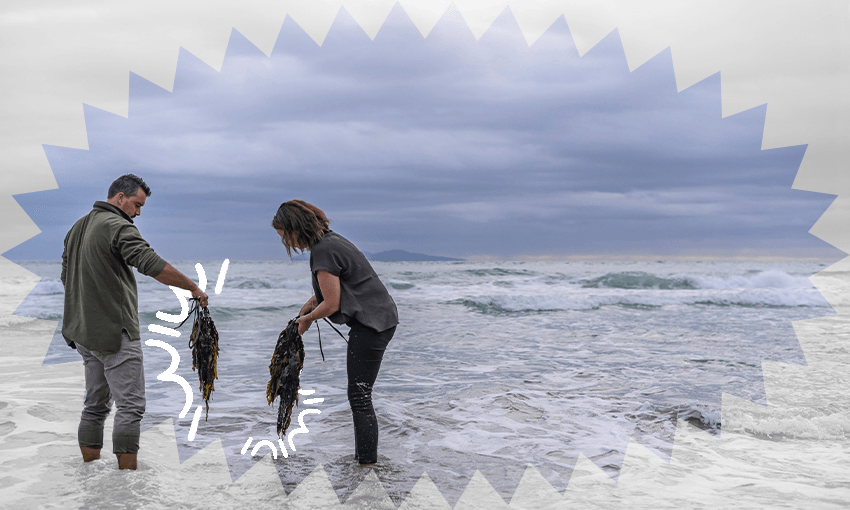Paeroa company AgriSea is using algae to pioneer solutions to everything from polluted waterways to chemical-heavy fertilisers.
New Zealand’s flora are known for their many healing properties – from mānuka to kawakawa, kōwhai to horopito. But one variety of flora that is found all over our country may not have been given as much credit as it deserves: algae.
There are thousands of varieties of algae, all with different applications and qualities that we’re only just starting to explore. Paeroa-based company AgriSea has made a name for themselves as leaders in the exploration of seaweed’s many qualities.
They’re pioneering solutions to dirty rivers, methane outputs of cattle, traditional fertilisers, nano cellulose technologies and even soft drinks. With 25 years of innovation under their belt, this multigenerational company is still going from strength to strength, winning Māori company of the year at the 2022 Hi Tech Awards.
AgriSea CEO Clare Bradley and chief innovation officer Tane Bradley joined Simon Pound on Business is Boring to talk about the wonders of this often underrated plant.
On Business is Boring, the award-winning weekly podcast series brought to you by The Spinoff and Spark Lab, host Simon Pound talks to everyone from accidental entrepreneurs to industry leaders about their business journeys and what propelled them to where they are today.
Listen on Apple Podcasts, Spotify or your favourite podcast provider.
Simon Pound: How did AgriSea begin?
Tane Bradley: Mum and my stepfather, Keith, went away down to the Hawke’s Bay. They were wwoofing, which is when you work on organic farms and trade that off for boarding and food. It was on one of these farms that they noticed an absolute difference; the farm was healthier, the animals were better, the fruit tasted better… and the farmer’s main input was seaweed.
The company began in the fertiliser space, so what do the traditional fertilisers do, and what does seaweed do better?
Clare Bradley: A lot of our soil contains really rich nutrients, and when you add seaweed it basically feeds all the bugs. The bugs’ job, just like in our stomach, is to access nutrients and make them available in a form that the plant can utilise really quickly. So it’s kind of like either feeding fast food versus feeding really nutritious probiotic formulas to grow.
So over 25 years, the company has built itself to where it is now, how did the founders get that momentum? Because I imagine turning up to farmers 25 years ago saying “hey, here’s some seaweed” probably was a bit of a long sales conversation.
Tane: What was respected out there was the sheer grit and determination that both mum and Keith had, and continually going up to the gates and educating farmers on how working together can be beneficial for the farm and the animals.
Clare: Originally, it was for home gardeners… Once we began selling product to people for whom the land is their living, that started another phase completely for the company – about research and development, testing, and trialling, what these products can do on monoculture commercial growing systems.
Kiwifruit was the first industry we researched really heavily, and found results like increased fruit size and quality. It’s really important for us to make sure that the products we’re selling add value, and are backed by research and science.
It makes so much sense that the fruit is going to taste better if it comes from healthier, more abundant ecosystems than thin monocrops where you kill everything that isn’t what you need.
Clare: Across the world, research into the use of seaweed has quadrupled in the last 10 years. So our collective wisdom is growing. We’re not the weird hippies in the corner anymore, we’re getting invited to the parties and we’re making friends, and scientists and researchers are saying there is something here in these low concentrations that can really add value.
You started very much in that bionutrient space with fertiliser replacement, but today there’s so many areas of innovation – what are the main things you’re working on, and what kind of relationship do you have with the whenua and the moana around that?
Tane: We have coastal harvesters all around the country that pick up after storms, and high waves and winds. They go out there and hand-gather, which is absolutely brilliant and our most preferred way of getting seaweed to Paeroa.
We are also now working on growing it in the sea, working with green wave technology from the States and applying that to our pre-existing mussel lines. We’re trying to see how we can polyculture them both and benefit the environment at the same time.
Another exciting project we’re just about to hit the switches on is growing seaweed on land… We brought some technology over from Australia and reimagined it to suit our conditions here in New Zealand, so essentially what we’re doing is bringing in seawater, using a different type of seaweed to take out the excess nitrogen and phosphorus, and then we send the cleaner water back out to the ocean.
That’s never been done before and in 12 months time, once we have some really neat data sets, I can imagine hectares and hectares of these systems helping to clean up our waterways.

